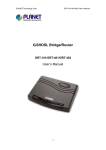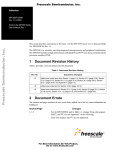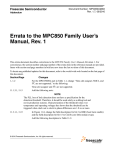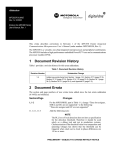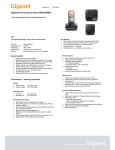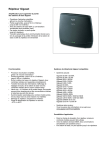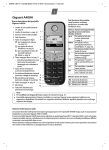Download Olicom A400A User's Manual
Transcript
Model: A400A ADSL Router User's Guide Version 1.19 (August 9, 2001) Contents Important Safeguards ................................................................ 1 Overview ................................................................................. 3 1. Packing list ......................................................................................... 3 2. Taking a look at the ADSL router ........................................................ 4 2.1 Front View.................................................................................... 4 2.2 Rear View .................................................................................... 5 Installation ................................................................................. 6 1. Setting up the router ........................................................................... 6 2. Installation of the application program of RouterAP .......................... 8 Configuration.............................................................................. 9 1. Configuring the ADSL router .............................................................. 9 2. Quick Setup ..................................................................................... 3. Advanced Configuration .................................................................. LAN ................................................................................................. DHCP .............................................................................................. IP Sharing........................................................................................ Routing Protocol (RIP) .................................................................... ISP (Internet Service Provider) ....................................................... Spanning Tree ................................................................................. SNMP .............................................................................................. ATM Interface & VCs ...................................................................... 4. Special Function.............................................................................. Packet Filter .................................................................................... 5. Maintenance .................................................................................... User Profile ..................................................................................... Monitor ............................................................................................ Show Setting ................................................................................... F/W Upgrade................................................................................... Ping ................................................................................................. Save configuration to file & Restore configuration from file........... Reset to Default .............................................................................. Save ................................................................................................ Reboot System ............................................................................... Information ...................................................................................... 12 23 23 24 28 33 36 37 38 41 42 42 44 44 46 47 49 49 50 50 50 51 51 Troubleshooting ....................................................................... 52 Important Safeguards Read and understand all instructions. follow all warnings and instructions marked on the product. Environment y In-house stationary use, desktop or wall-mounted; the maximum ambient temperature may not exceed 40°C (104°F) external to the housing; y It must not be mounted in a location exposed to direct or excessive solar and/or heat radiation; y It must not be exposed to heat trap conditions and must not be subjected to water or condensation; y It must be installed in a Pollution Degree 2 environment. Cleaning Unplug this product from the wall outlet before cleaning. Do not use liquid cleaners or aerosol cleaners. Use a damp cloth for cleaning. Water and moisture Do not use this product near water, for example, near a bathtub, wash bowl, kitchen sink, laundry tub, in a wet basement or near a swimming pool. Power sources This product should be operated only from the type of power source indicated on the marking labels. If you are not sure of type of power supply to your home, consult your product dealer or local power company. The main socket outlet must be near the equipment and easily accessible. The router equipment is not intended to be connected to an IT-type power system. Power cord protection Do not allow anything to rest on the power cord. Do not locate this product where the cord will be subject to persons walking on it. 1 Overloading Do not overload wall (mains) outlets and extension cords as this can result in the risk of fire or electric shock. Servicing To reduce the risk or electric shock, do not disassemble this product. None of its parts are user-replaceable; therefore, no reason exists to access the interior. Opening or removing cover may expose you to dangerous voltages or other risks. Incorrect reassembly can cause electric shock when the appliance is subsequently used. If service or repair work is required, take it to qualified service personnel. Damage requiring service Unplug the computer from the wall outlet and refer servicing to qualified service personnel under the following conditions: y If liquid has been spilled into the product; y If the product has been exposed to rain or water; y If the product does not operate normally by following the operating instructions; y If the product has been dropped or damaged in any way; y If the product exhibits a distinct change in performance. Modem/Telephone use Avoid using a modem/telephone (other than a cordless type) during an electrical storm. There may be a remote risk of electric shock from lightning. Do not use the telephone to report a gas leak in the vicinity of the leak. If telephone service is required on the same line and for optimum ADSL performance or distributed filters must be installed. Depending on your ADSL configuration and type of filters, installation must be carried out by qualified service personnel. Consult your Telephone Company of ADSL Service Provider for instructions. SAVE THESE INSTRUCTIONS 2 Overview 1. Packing list Before set up the machine, inspect it visually for damage that might have occurred during shipment. Make sure the box contains all of the components listed below: 1. ADSL router 2. RJ-11 to RJ-11 phone cable 3. Adapter 4. DB-9 to RJ-14 Console cable (RS232) 5. RJ-45 to RJ-45 Ethernet cable 6. External Filter 7. CD-ROM (include: Configuration program of ADSLRouter, User guide) 8. User guide 1 2 3 4 5 6 7 8 3 2. Taking a look at the ADSL router 2.1 Front View LED Name ADSL Tx/Rx LAN Activity POWER State on flash flash off On Off Flash Off On Off Meaning ADSL line is ready for data transmission ADSL line is ready for line connection Data is being transmitted/received No transmit/receive activity PC and the device is properly connected PC and the device is not connected Data is being transmitted/received No transmit/receive activity Power on No power 4 2.2 Rear View The LINE port lets you connect the device to one or more remote networks over a ADSL connection. The PHONE port lets you connect to the telephone line. The CONSOLE port lets you connect the device to a personal computer through the console cable to configure, administer and monitor your ADSL router setting with Graphic User Interface (GUI). The DC IN port lets you connect the device to an electrical power supply. The LAN port lets you connect network devices within a workgroup. 5 Installation 1. Setting up the router ADSL Service Port on Wall RJ-45 Ethernet cable RJ-11 cable Adapter External Filter DB-9 to RJ-14 Console cable The location environment Place the router in a location where air can circulate freely around it. The router case has vents on top cover and its sides. Leave at least two (2) inches of clearance between the vents on the both sides of the router and any object that might restrict air flow. Never operate the router when its vents are covered or obstructed. Connect your Wide Area Network Plug one end of the phone cable in the port labeled LINE on the rear panel of router until you feel it lock and connect the other end of line to your ADSL wall jack. Connect the CONSOLE port The CONSOLE port lets you connect the router to a personal computer through the console cable to configure, administer and monitor your ADSL router setting with Graphic User Interface (GUI). (described in the chapter of Configuration on page 10) 6 a. Plug the RJ-14 end of console cable into the CONSOLE port on the router back panel. b. Connect the other DB-9 end of console cable to a serial port (COM1 or COM2) of your computer. Connect the local devices 1. Insert one end of a ethernet cable into the ports labeled LAN port on the rear panel of router until you hear click. 2. Connect the other end of the cable to the ethernet port on a personal computer or other networked device. 3. If you require more than one hub port, you can connect the router to another hub. Connect the adapter Plug the adapter connector into the socket labeled DC IN on the back of the router and connect the other end into a properly wall outlet. Note: 1. The power rating of the adapter is "Input: 220V 50Hz, Output: 9Vdc 1.1A". 2. There is no power switch on this router. The power is on as long as the router is plugged in. Install a telephone filter Converting your regular phone line into a high-speed Digital Subscriber Line (DSL) can cause audible noise (high-pitched tones and static) when you talk on the phone. You need to install a filter on each telephone or device that shares the DSL Line to eliminate this noise. Place on filter in every telephone jack that is directly connected to a telephone, answering machine, fax or any other phone line device. Unused jacks do not need a filter. 7 2. Installation of the application program of Router AP 1. Start operation system. 2. Place the CD into your CD-ROM drive. Remember to allow the drive fully getting the CD running before proceeding. 3. The Setup program will automatically install all of the required files into the default c:\Program Files\ADSLRouter subdirectory. Follow all onscreen instructions and then click "Finish" to complete the installation. 4. Or you may click "Start" and select "Run" from the pop-up menu. Type "D:\Driver\Utility\Setup.exe" (Some user's CD-ROM driver could designated to E, in this case, please select E:\Driver\Utility\Setup.exe). Follow all onscreen instructions and then click "Finish" to complete the installation. Note: If your PC systems Windows OS is Win 95, you have to install the program of WinSock 2.0 again after installation. 8 Configuration 1. Configuring the ADSL router When you power up the router and launch the application program of ADSLRouter and select "ADSL Router Configuration", the window will display a Login screen and ask you to enter the user name and password, as shown below: 1. User: Enter Your username lets the router record your access. Give a username to validate its authorization. The default for user is "user1". 2. Password: Enter the administrator password lets you display and update all this router settings (The default is "root"). Enter a user password lets you display but not update this router settings (the default is test). 3. Click Option button to choose connection method. 9 Options are : Serial port, Network Serial port :You can use the attached console cable to connect the router and a personal computer to configure, administer and monitor your ADSL router with Graphic User Interface (GUI). a) Plug the RJ-14 end of console cable into the CONSOLE port on the router back panel. b) Connect the other DB-9 end of console cable to a serial port (COM1 or COM2) of your computer. Network: Or you can open a Network connection from a workstation on your network. You must know the IP address of the router before you can make a Network connection to it. By default , the router uses 192.168.1.1 as the IP address for its LAN interface. You can use the Graphic User Interface (GUI) to configure the router IP address. Retry interval: Enter the timing of how many seconds you want to reconnect the router if failure. (The default is 3 seconds.) 10 When you have logged in successfully, the Graphic User Interface (GUI) will appear on the window to let you configuration the router. The menu of Quick Setup opens the Quick Setup window, which lets you enter basic settings for the router. The menu of Advanced Configuration provides information on advanced management features for network managers such as LAN, DHCP, IP Sharing, Router Protocol etc. The menu of Special Function includes Packet Filter. The menu of Maintenance describes maintenance features for checking system status and F/W upgrade etc. Note: Double click each options of main page to enter each Graphic User Interface (GUI) configuration window to enter parameter. 11 2. Quick Setup Gathering Configuration Information Before you configure this ADSL router, you need to gather information about your networks. Most users will only need to complete the Quick Setup section. For many users, the default configuration of the product will provide all the necessary services. Some DSL service providers may require settings that vary from the default configuration. In such cases, you should contact the service provider or network administrator and have them complete the Quick Setup. Entering Basic Settings The Quick Setup window lets you enter basic configuration information for your ADSL router. If you have overridden the default settings for IP address information and entered IP address information manually, you can use the Quick Setup window to display and modify those settings. Quick Setup is an easy and quick way to set up this ADSL router and let it connect/communicate with ISP to access Internet service. Before configuring, you should read carefully the part of Installation and configuration. You also need some information provided by your ISP to proceed the ADSL router setup and configuration. This ADSL router supports three kinds of protocol and provides five kinds of operation mode. To decide what kind of protocol, it depends on the structure and services provided by your Internet Service Provider, please follow the instruction of Quick Setup window to enter the parameter. Note: Click the question mark in the title bar of the dialog box to view on-line description about each field of the Graphic User Interface. 12 PPPoE The Bridged protocol data unit is encapsulated using RFC 1483 protocol over an ATM network and this operation supply PPPoE function to let the router connect with ISP. 1. VPI: Enter the number of the virtual path identifier in the VPI field. The VPI is a number in the range 0-255. Consult your ATM transport administrator for what number you should enter in this field. 2. VCI: Enter the number of the virtual circuit identifier in the VCI field. The VCI is a number in the range 0-65534. Consult your ATM transport administrator for what number you should enter in this field. 3. Encapsulate: Select the encapsulation setting. You choose LLC or VC Mux to configure whether the virtual circuit uses LLC-SNAP encapsulation or Vc-based multiplexing. 4. Account: Enter the account provided by your ISP in the Account field. 5. Password: Enter the password provided by your ISP in the Password field. 6. Remote DNS: Enter the IP address of your domain name server in the Remote DNS field. A domain name server is a network computer responsible for matching host names to numeric IP addresses so that network traffic can be routed correctly. Your Internet Service Provider can provide the IP address of their domain name server. 13 In the case of PPP connection, the remote access server will be assign this field automatically. Unless you should fill it by manual. 7. Idle time out: Enter the timing of how many minutes you want to stop to connect when idle. 8. Click the OK button to store your modified configuration in this ADSL router memory. Or click Cancel button to return to main page. Note: Please execute the actions of Save and Reboot to make the new connection after configured the Quick Setup. 14 RFC 1483 bridge (EoA) Bridged protocol data unit is encapsulated using RFC 1483 protocol over an ATM network and this operation mode using ATM/ADSL to execute as a Ethernet's bridge. 1. VPI: Enter the number of the virtual path identifier in the VPI field. The VPI is a number in the range 0-255. Consult your ATM transport administrator for what number you should enter in this field. 2. VCI: Enter the number of the virtual circuit identifier in the VCI field. The VCI is a number in the range 0-65534. Consult your ATM transport administrator for what number you should enter in this field. 3. Encapsulate: Select the encapsulation setting. You choose LLC or VC Mux to configure whether the virtual circuit uses LLC-SNAP encapsulation or Vc-based multiplexing. 4. Gateway: Use the Gateway Address field to specify the IP address of the default IP gateway. 5. Remote DNS: Enter the IP address of your domain name server in the Remote DNS field. A domain name server is a network computer responsible for matching host names to numeric IP addresses so that network traffic can be routed correctly. Your Internet Service Provider can provide the IP address of its domain name server. 15 6. Click the OK button to store your modified configuration in this ADSL router memory. Or click Cancel button to return to main page. Note: Please execute the actions of Save and Reboot to make the new connection after configured the Quick Setup. 16 Routing over RFC 1483 bridge Bridged protocol data unit is encapsulated using RFC 1483 protocol over an ATM network and this operation mode use ATM/ADSL to simulate as a Ethernet network router to route information between LANs. 1. VPI: Enter the number of the virtual path identifier in the VPI field. The VPI is a number in the range 0-255. Consult your ATM transport administrator for what number you should enter in this field. 2. VCI: Enter the number of the virtual circuit identifier in the VCI field. The VCI is a number in the range 0-65534. Consult your ATM transport administrator for what number you should enter in this field. 3. Encapsulate: Select the encapsulation setting. You choose LLC or VC Mux to configure whether the virtual circuit uses LLC-SNAP encapsulation or Vc-based multiplexing. 4. IP: Enter the IP address the ADSL router will use on this virtual circuit in the IP Address field. The IP address you enter must not be in use by other devices on this virtual circuit. The domain of Ip have to not same as LAN. 17 5. Netmask: Enter the subnet mask for the network connected to this virtual circuit in the Netmask field. The subnet mask specifies which bits of the 32-bit binary IP address represent network information. Most sites should use 255.255.255.0 for their subnet mask. 6. Gateway: Use the Gateway Address field to specify the IP address of the default IP gateway. 7. Remote DNS: Enter the IP address of your domain name server in the Remote DNS field. A domain name server is a network computer responsible for matching host names to numeric IP addresses so that network traffic can be routed correctly. Your Internet Service Provider can provide the IP address of its domain name server. 8. Click the OK button to store your modified configuration in this ADSL router memory. Or click Cancel button to return to main page. Note: Please execute the actions of Save and Reboot to make the new connection after configured the Quick Setup. 18 RFC 2364 PPPoA The Framing PPP packet is encapsulated using RFC 2364 protocol over an ATM network and this operation mode use PPP/ATM/ADSL to make a PPP connection with ISP. The other side of PC or LAN can follow this PPP connection to access Internet service. 1. VPI: Enter the number of the virtual path identifier in the VPI field. The VPI is a number in the range 0-255. Consult your ATM transport administrator for what number you should enter in this field. 2. VCI: Enter the number of the virtual circuit identifier in the VCI field. The VCI is a number in the range 0-65534. Consult your ATM transport administrator for what number you should enter in this field. 3. Encapsulate: Select the encapsulation setting. You choose LLC or VC Mux to configure whether the virtual circuit uses LLC-SNAP encapsulation or Vc-based multiplexing. 4. Account: Enter the account provided by your ISP in the Account field. 5. Password: Enter the password provided by your ISP in the Password field. 19 6. Remote DNS: Enter the IP address of your domain name server in the Remote DNS field. A domain name server is a network computer responsible for matching host names to numeric IP addresses so that network traffic can be routed correctly. Your Internet Service Provider can provide the IP address of its domain name server. In the case of PPP connection, the remote access server will be assign this field automatically. Unless you should fill it by manual. 7. Click the OK button to store your modified configuration in this ADSL router memory. Or click Cancel button to return to main page. Note: Please execute the actions of Save and Reboot to make the new connection after configured the Quick Setup. 20 IPoA (RFC 1483 route) The Routed protocol data unit is encapsulated using RFC 1483 protocol over an ATM network and this operation mode connect and communicate directly with Internet through ATM/ADSL. 1. VPI: Enter the number of the virtual path identifier in the VPI field. The VPI is a number in the range 0-255. Consult your ATM transport administrator for what number you should enter in this field. 2. VCI: Enter the number of the virtual circuit identifier in the VCI field. The VCI is a number in the range 0-65534. Consult your ATM transport administrator for what number you should enter in this field. 3. Encapsulate: Select the encapsulation setting. You choose LLC or VC Mux to configure whether the virtual circuit uses LLC-SNAP encapsulation or Vc-based multiplexing. 4. IP: Enter the IP address the ADSL router will use on this virtual circuit in the IP Address field. The IP address you enter must not be in use by other devices on this virtual circuit. The domain of Ip have to not same as LAN. 5. Netmask: Enter the subnet mask for the network connected to this virtual circuit in the Netmask field. The subnet mask specifies which bits of the 32-bit binary IP address represent network information. Most sites should use 255.255.255.0 for their subnet mask. 21 6. Gateway: Use the Gateway Address field to specify the IP address of the default IP gateway. 7. Remote DNS: Enter the IP address of your domain name server in the Remote DNS field. A domain name server is a network computer responsible for matching host names to numeric IP addresses so that network traffic can be routed correctly. Your Internet Service Provider can provide the IP address of its domain name server. 8. Click the OK button to store your modified configuration in this ADSL router memory. Or click Cancel button to return to main page. Note: Please execute the actions of Save and Reboot to make the new connection after configured the Quick Setup. 22 3. Advanced Configuration LAN If you want to customize the settings for the Ethernet interface on your router, enter or change following information in the LAN window. IP Address The IP address of this router on the network connected to its LAN interface. Netmask The range of subnet mask in use for the LAN connected to the Ethernet port. Default is 255.255.255.0 LAN type The IP address uses on the LAN is Virtual IP or Global IP. Virtual IP is just used on the LAN. Global IP is used on the Internet. Click the OK button to store your modified configuration in this ADSL router memory. Or click Cancel button to return to main page. 23 DHCP Dynamic Host Configuration Protocol (DHCP) is most used on LAN to manage IP on each host, specifically used on Virtual IP environment. In DHCP Server mode, this router automatically assign IP settings to a workstation on your LAN. Generic Configure DHCP mode and related parameters in the router. 1. DHCP Mode: Click Disable to turn off the DHCP service or select Server/Client. Server Mode: If you select Server, for small home LANs it might be interesting to configure all you PCs as DHCP Clients and the A400A as DHCP Server. In this configuration each time a computer boots, it will obtain its IP configuration from the A400A. 24 2. IP: Specify the first address from the DHCP client. It should be within the same subnet you have configured on your LAN and should not be the same IP address on LAN. 3. Range: Enter a number in the range 1-254. 4. Essential: The IP address of the essential DNS name server for your network. 5. Optional: Enter optional IP address of DNS server on DHCP client. 6. Click the OK button to store your modified configuration in this ADSL router memory. Or click Cancel button to return to main page. Client Mode: If you select Client, for advanced networks, the role of DHCP Server might be performed by an IP node other than the A400A on the local LAN. Typically such functions are attributed to Home Gateways: computers having better networking capabilities than the other hosts on the home LAN. All local PCs remain configured as DHCP Clients, including the A400A. Note: After you change DHCP mode from "Disable/Server" to "DHCP Client mode" and if you would like to active this setting immediately you must execute the functionality of "Save" and "Reboot" at first, after this procedure you just can enter the window of Client Configuration and execute related configuration. 25 In DHCP Client mode, you can get IP address and related information for this router from DHCP server. 1. 2. 3. 4. 5. 6. IP Address: The IP address of the device Subnet mask: The Subnet mask of the device. Default Gateway: The default gateway of the device. DHCP Server Address: The IP address of your DHCP Server. DNS Server Address: The IP address of your DNS Server. Release button: Before you start to get a new IP address, you must release the old configuration. 7. Renew button: Start to get IP address and some information from DHCP Server. 8. Click OK button to complete the DHCP Client Configuration and return to previous window. 26 Fixed You can assign some correspondence Mac Address to some fixed IP. Please input Mac address and corresponding IP address. After you click the Add button, your setting is shown in the table below. You can add new information or delete unused one in the table. Click Add button to save information. The configuration page adds a new row to show this setting. You can click Delete button to delete a chosen setting. Or you can click Replace button to replace original setting. Click the OK button to store your modified configuration in this ADSL router memory. Or click Cancel button to return to main page. 27 IP Sharing Usually for the home user or the SOHO user, you only can apply one or a few Internet IP Addresses which sometimes are not enough for many hosts on the LAN to access Internet service at the same time. This function provide the solution for such problem. Virtual Server The ADSL router can set up different functions server on the different host site of LAN through one Internet IP address. NAT (Network Address Transfer) NAT can correlate virtual IP/Global IP in static or dynamic way. 1. Service name: Enter a name for virtual server. 2. External port: Enter the port number which is correspond to the Global IP on virtual server. 3. Interface: Use the dropdown menu to select a number from 1 to 8 (please refer the settings in ATM & VC service mode). 4. IP address: Enter the IP address you want to enable for virtual server. 5. Protocol: Use the dropdown menu to select the Protocol (TCP or UDP) of virtual server service. 28 6. Internal port: Enter the port number your virtual server service use. The range of this field is 0 to 65534. 7. Click Add button to save information. The configuration page adds a new row to show this setting. You can click Delete button to delete a chosen setting. Or you can click Replace button to replace original setting. 8. Click the OK button to store your modified configuration in this ADSL router memory. Or click Cancel button to return to main page. 29 NAT Local address 1. Base address: Enter the local (virtual) IP address you want to enable for address translation. 2. Range: Enter the number of local (virtual) address. 3. Click Add button to save information. The configuration page adds a new row to show this setting. You can click Delete button to delete a chosen setting. Or you can click Replace button to replace original setting. 4. Click the OK button to store your modified configuration in this ADSL router memory. Or click Cancel button to return to main page. 30 NAT Global address 1. Base address: Enter the global IP address you want to enable for address translation. 2. Interface: Use the dropdown menu to select a number from 1 to 8 (please refer the settings in ATM & VC service mode). 3. Count: Enter the number of global address. 4. Click Add button to save information. The configuration page adds a new row to show this setting. You can click Delete button to delete a chosen setting. Or you can click Replace button to replace original setting. 5. Click the OK button to store your modified configuration in this ADSL router memory. Or click Cancel button to return to main page. 31 Fixed NAT mapping 1. Local address: Enter the local (virtual) IP address you want to enable for fixed address translation mapping. 2. Global address: Enter the global address which is corresponded to local address. 3. Interface: Use the dropdown menu to select a number from 1 to 8 (please refer the settings in ATM & VC service mode). 4. Click Add button to save information. The configuration page adds a new row to show this setting. You can click Delete button to delete a chosen setting. Or you can click Replace button to replace original setting. 5. Click the OK button to store your modified configuration in this ADSL router memory. Or click Cancel button to return to main page. 32 Routing Protocol (RIP) RIP sends routing-update messages at regular intervals and when the network topology changes. When a router receives a routing update that includes changes to an entry, it updates its routing table to reflect the new route. RIP routers maintain only the best route (the route with the lowest metric value) to a destination. Static Route You can set up static route table for some fixed domain address path. 1. Network: Specify the destination host. 2. Netmask: Specify a subnet mask value to be associated with this route entry. The subnet mask specifies which bits of the 32-bit binary IP address represent network information. Most sites should use 255.255.255.0 for their subnet mask. 3. Gateway: Use the Gateway Address field to specify the IP address of the default IP gateway. 4. Click Add button to save information. The configuration page adds a new row to show this setting. You can click Delete button to delete a chosen setting. Or you can click Replace button to replace original setting. 5. Click the OK button to store your modified configuration in this ADSL router memory. Or click Cancel button to return to main page. 33 Generic Specifies a number of stability features. To adjust for rapid network-topology changes and prevents routing loops from continuing indefinitely, to have a faster and safer routing. 1. RIP: Click Enable to turn on RIP service and go to step 2. If not, click OK/Cancel button to return to main page. 34 2. Interface: Use the dropdown menu to select a number from 1 to 8 (please refer the settings in ATM & VC service mode). 3. Mode: Use the dropdown menu to select the mode. Options are: Disable: Select Disable to turn off RIP service for the certain interface. Enable: Select Enable to turn on RIP service for the certain interface. Silent: Select Silent for receiving routing information only. 4. Version: Use the dropdown menu to select the version. RIP-Send/receive specify whether you want the router to send Routing Information Protocol (RIP) messages to other routers. Option are: RIP-1 - Broadcast/Accept routing information in RIP version 1 format. RIP-2- Multicast/Accept routing information in RIP version 2 format. 5. Type: Use the drop down menu to specify whether the router accepts administrative commands received over this virtual circuit. Options are: NONE, PASSWORD, MD5 6. Code: Enter the password (up to 15 characters) when you select the type of PASSWORD or MD5 on above step 5. 7. Enable poison reverse: When network topology change, especially for this router detect some route disappear, this router will keep routing information from being used for a period of time and notify its unlimited distance to other communication servers. 8. Click the OK button to store your modified configuration in this ADSL router memory. Or click Cancel button to return to main page. 35 ISP (Internet Service Provider) If you have several ISP accounts, you can input the related information of each ISP on this window. It can let you change ISP access conveniently or proceed the configuration when access simultaneously. Select a ISP name, make necessary change, then click Replace button to replace original setting. Click the OK button to store your modified configuration in this ADSL router memory. Or click Cancel button to return to main page. 36 Spanning Tree The Spanning Tree algorithm that is used to avoid packet looping in your network. 1. Service: Click Enable to turn on spanning tree service and go to step 2. If not, click OK/Cancel to return main page. 2. Bridge Priority: Enter the value of root bridge, the range of this field is 0 to 65535. Each bridge has its own identification code. The code can be used to decide which bridge will be the root bridge. The bridge with smallest identification code will be the root bridge. 3. Hello Timer: Enter the timing interval which root bridge will produce a communication frame. 4. Forward Delay: Enter the longest timing that a communication frame is transmitted/received through all bridges. 5. Max Age: Enter the existing timing of each communication frame. 6. Click the OK button to store your modified configuration in this ADSL router memory. Or click Cancel button to return to main page. 37 SNMP The Simple Network Management Protocol (SNMP) lets a network administrator monitor problems on a network by retrieving settings on remote network devices. Network administrator typically runs an SNMP management station program such as MIB browser on a local host to obtain information from an SNMP agent such as the A400A. 1. System Contact: Enter information about the system contact person in the System Contact field. For example, you might enter the email address of the person responsible for the A400A. 2. System Name: Enter information about the system name in the System Name field. For example, you might enter the administratively-assigned name for the A400A. 3. System Location: Enter information about the system location in the System Location field. For example, you might enter the physical location of this node such as building, floor, or room number where the A400A is located. 4. Click the OK button to store your modified configuration in this ADSL router memory. Or click Cancel button to return to main page. 38 Community tab 1. Community: Identify the SNMP communities to which the A400A belongs by entering a community name in the Community Field. By default, the A400A is associated with the public community. You can associate as many as 5 communities with the A400A. 2. Access right: Use drop down menu to select the access right from read only, read/write or deny under this community name. 3. Click Add button to save information. The configuration page adds a new row to show this setting. You can click Delete button to delete a chosen setting. Or you can click Replace button to replace original setting. 4. Click the OK button to store your modified configuration in this ADSL router memory. Or click Cancel button to return to main page. 39 Trap tab 1. Version: Use drop down menu to select the version. 2. Community: Enter the name of the community for which the trap destination is responsible in the Community field. 3. Trap host IP: Enter the IP address of a host acting as an SNMP console which A400A should send SNMP trap messages in the Trap host Ip filed. 4. Click Add button to save information. The configuration page adds a new row to show this setting. You can click Delete button to delete a chosen setting. Or you can click Replace button to replace original setting. 5. Click the OK button to store your modified configuration in this ADSL router memory. Or click Cancel button to return to main page. 40 ATM Interface & VCs This ADSL router connect/communicate with WAN via ATM/ADSL. In the ATM structure, this ADSL router has VC (Virtual Circuit) function and It can set up one or several Virtual Interfaces to proceed connection/ communication individually or simultaneously. You can configure ATM settings for each virtual circuit. The selection made for one virtual circuit does not affect other virtual circuits. The screen that appears depends on the operation mode you selected. The information you want to configure on each interface is supplied by your ISP, the content is same as Quick Setup. Please refer to page 12 the instruction of Quick Setup. Click the OK button to store your modified configuration in this ADSL router memory. Or click Cancel button to return to main page. Note:If you would like to configure the router as multi-VCC, these VCCs will share your modem bandwidth. Please be careful with your application 41 4. Special Function Packet Filter This ADSL router provides a simple protection against those unwanted information/data from passing through LAN to WAN or WAN to LAN. To limit some hosts on the LAN to access Internet service. To limit some source from Internet to enter the LAN. 1. Packet Filter Enable: Click here to turn on packet filter service. If not, please return to main page. 2. Any ip on Source Address session: Click here to define every data packet from source address to be in the same priority/ protocol/action. 3. Or you can restrict certain IP address to deny internet service or access it. Enter the restricted IP address in the IP field and related information (Mask, Port) in the Mask and Port fields. 4. Any ip on Destination Address session: Click here to define every data packet from source address to be in the same priority/protocol/action. 42 5. Or you can restrict certain IP address to deny the LAN or enter it. Enter the restricted IP address in the IP field and related information (Mask, Port) in the Mask and Port fields. 6. Priority: Enter a number to specify the priority of this rule. 1 is the highest and 65534 is the lowest. 7. Protocol: Enter the protocol that the rule used. 8. Action: You can choose to allow the data packet which you chose to deny internet service or access it. 9. Click Add button to save information. The configuration page adds a new row to show this setting. You can click Delete button to delete a chosen setting. Or you can click Replace button to replace original setting. 10. Click the OK button to store your modified configuration in this ADSL router memory. Or click Cancel button to return to main page. 43 5. Maintenance User Profile This item provides you to manage each user's information and the limit of authority. This ADSL router let different users configure the parameters for different level according to the limit of authority. General user manage Click Add button to save information. The configuration page adds a new row to show this setting. You can click Delete button to delete a chosen setting. Or you can click Replace button to replace original setting. Click the OK button to store your modified configuration in this ADSL router memory. Or click Cancel button to return to main page. 44 Supervisor tab You may click Supervisor button to change the supervisor password. 45 Monitor This item provides the current information about the operation of ADSL router and there are three options (Route, ADSL and ATM) for you to monitor. Click the OK button to start monitoring selected items, and the status will display in tables on right side of main page. Or click Cancel button to return to main page. Routing table No. Type Network Address Netmask Gateway 1 C 192.168.1.0 255.255.255.0 192.168.1.0 2 C 127.0.0.1 255.255.255.255 127.0.0.1 3 4 5 6 7 8 9 10 Interface 192.168.1.0 127.0.0.1 Port Name IF0 Loopback ADSL Generic Name Result Buid-in Diagnostic Test Successful DME Register Read/Write Test Successful SW Status R-QUIET Init Status Successful C-ACT-REQ Not Detected Item Up Stream Duplex Down Stream Duplex Down Stream Simplex ADSL Bit Rate Actual(kbps) 0 0 0 No. IP Address Netmask 1 192.168.1.1 255.255.255.0 2 3 4 5 6 7 8 VPI 0 Max(kbps) 0 0 0 ATM VCI Encapsulation Link Type 33 LLC Ethernet 46 Status Down Show Setting This item provides a summary of some function configurations, you may get the information you want quickly or print the information. Click the OK button to show the parameters tables of those items that you selected on your right side of main page. Or click Cancel button to return to main page. Click Print button to print out the data. No. 1 2 3 4 5 6 7 8 Status Enable Disable Disable Disable Disable Disable Disable Disable No. 1 No. 1 No. 1 VPI 0 0 0 0 0 0 0 0 VC VCI 33 0 0 0 0 0 0 0 Encapsulation LLC VC_Mux VC_Mux VC_Mux VC_Mux VC_Mux VC_Mux VC_Mux Virtual Server Mapping Serve Name Protocol External Port Host IP Internal Port NAT Local Address Range Base Address Range NAT Global Address Range Base Address Count Interface Fixed NAT Mapping No. Local Address Global Address 1 Interface Packet Filter Module Packet Filter Module Enable 47 Interface No. Priority Action Protocol Packet Filter Rule Source Source Source Destination Destination Address Mask Port Address Mask Destination Port 1 Generic DHCP Parameters Server Enable Default Gateway 192.168.1.1 Subnet Mask 255.255.255.0 DHCP Start IP 192.168.1.2 DHCP IP Count 20 Name Server IP 192.168.1.1 Name Server IP Name Server IP Fixed Host Entries No. IP Address Ethernet Address 1 No. 1 Network Address 0.0.0.0 Static Route Netmask 0.0.0.0 Gateway Address 200.1.1.2 RIP RIP Mode Disable Auto Summary Disable Interface 1 2 3 4 5 6 7 8 Mode Enable Disable Disable Disable Disable Disable Disable Disable RIP Version 2 1 1 1 1 1 1 1 Interface RIP parameter Authentication Poison Reverse None Enable None Disable None Disable None Disable None Disable None Disable None Disable None Disable Generic Bridge Parameter Bridge Function Enable IP Address 192.168.1.1 Netmask 255.255.255.0 No. 1 2 3 4 ISP Name Office-1 Office-2 Office-3 Office-4 ISP User Account user1 user2 user3 user4 User Password *************** *************** *************** *************** 48 Authenticate code *************** *************** *************** *************** *************** *************** *************** *************** F/W Upgrade You can install new firmware in the router from any computer capable of functioning as a Trivial File Transfer Protocol (TFTP) server or FTP Server. If the firmware has been stored in your PC hard disk, you can use local F/W upgrade, too. This function is used for maintenance. Please proceed carefully when install new F/W. Ping It is a sub set of the general command same as Ping utility. It is used to detect whether this ADSL router is connected/communicated with other network or not. 49 Save configuration to file from file & Restore configuration These two utilities are especially for system backup. When you have configured the system parameters. You can save it to file, and restore it into system if necessary in future. Reset to Default When the configuration of system parameters becomes in disorder/ confused, you may choose to let system parameters reset to start-up default or reset to factory default. Save All of your configurations are stored temporarily in the system. If you want to keep these configurations after the device reboot, you have to execute this item. 50 Reboot System Some functions are not able to start to work after configuration. You need to Save and Reboot the system to active those new settings. Note: After you reboot system, you have to re-login the system again. Information Click this item to view the system information of the router. is listed below for reference. Model System Version CPU RAM Flash Chipset Modem F/W Version Server IP Address MAC Address Hostname PPP Encryption PPP Authentication System up time Syn. up time PPP up time Information A400 Version 2.1 06/18/2001 MPC850DSL at 48 MHz 8MB 2MB AD20msp930 3110BE47 127.0.0.1 00:01:E1:00:01:37 ATU-R None PAP 0 day 1 hour 27 min 18 sec 0 day 0 hour 0 min 0 sec 0 day 0 hour 0 min 0 sec 51 A sample Troubleshooting Below are the potential problems you may run into and the possible solutions. After each problem description, some instructions are provided to help you to diagnose and to solve the problem. Problem Action None of the LEDs are on when Check the connection between the AC you turn on the router adapter and the router. If the error persists, you may have a hardware problem. In this case you should contact technical support. Cannot access the router via Check to see if the router in connected to the console port your computer’s serial port. Cannot ping any station on the Check the Ethernet LEDs on the front panel. LAN The LED should be on for a port that has a station connected. If it is off, check the cable between your router and the station. Verify that the IP address and the subnet mask are consistent between the router and the workstations. Initialization of PVC connection Ensure that the cable is connected properly failed from the ADSL port to the wall jack. The ADSL SYNC led on the front panel of the router should be on. Check that your VPI, VCI, type of encapsulation and type of multiplexing settings are the same as what you collected from your telephone company and ISP. Reboot the router. If you still have problems, you may need to verify these variables with the telephone company and/or ISP. 52
























































